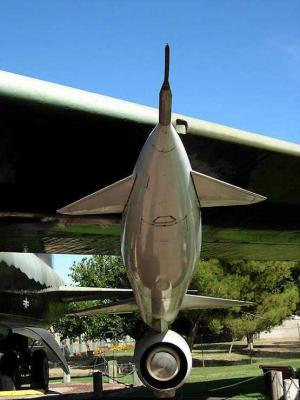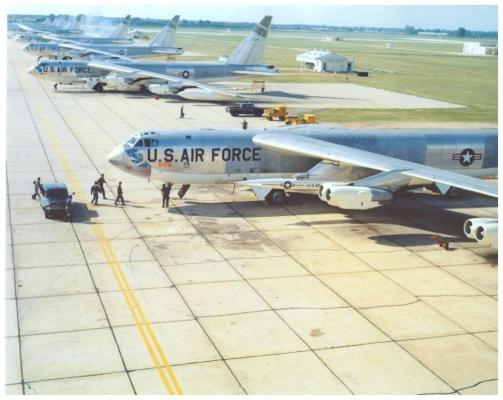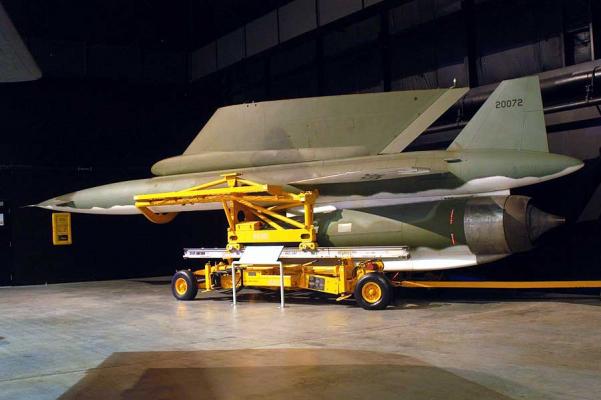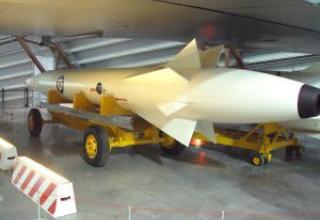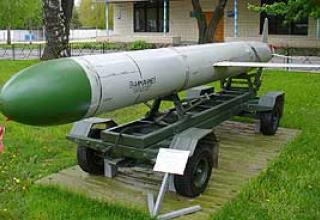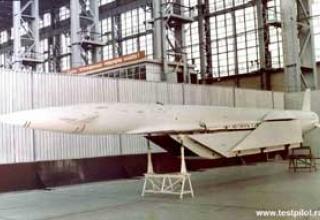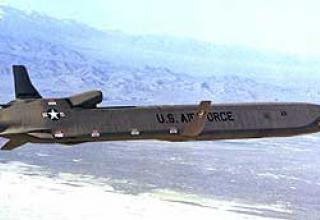The Hound Dog Cruise Missile (CBM) program began in 1956 - On March 15, the U.S. Air Force General Headquarters released the General Operation Requirement 148 (GOR 148) for the development of an air-to-ground missile, with the B-52 Stratofortress bomber as the carrier. Each aircraft was to carry two CRs on the outer suspension wing units. The new missiles were expected to be used primarily for the defeat of large air defense facilities with the further destruction of the main targets free-falling thermonuclear bombs of high power placed in the aircraft bombshell (in the future it was decided to allow the use of the missile and to destroy directly the main targets that had a strong air defense). In order to increase efficiency, two main methods of missile application were envisaged - high-altitude flight at high supersonic speed and short-range flight at low altitude with high subsonic speed. The project was developed as a so-called single "weapon system" - WS-131A. First of all, the carrier was considered to be the latest modification of Stratofortress bomber manufactured by Boeing Corporation - B-52G, which was still under development at that time.
August 23, 1957 the General Staff of the U.S. Air Force announced that after reviewing the proposed options contract for the development of a new missile was awarded to the company North American Aviation, Inc., named the main contractor of the program. The proposal by North American Aviation, Inc. was based on technology developed for the Navaho missile. The Chance Vought option as a further development of the Regulus missile was rejected. The power plant was assigned to Pratt & Whitney Corporation, and the Autonetics Division of North American Aviation, Inc. was to be responsible for the missile's control system, performing work on both the inertial IC unit and the onboard computer. The astro-orientator for the control system was developed by the Kollsman Instruments Company. The combat unit was traditionally created by the Atomic Energy Commission (Atomic Energy Commission) - first of all, the LosAlamosScientificLaboratory (the payload) and SandiaLaboratory (the combat unit and its integration with the CR).
Under the contract signed on September 16, 1957, Boeing, as the lead contractor, was responsible for the mutual integration of the two main components of the new "weapon system" - the missile and the bomber; Boeing was also responsible for the first test launches of the new missile, and was tasked with developing a pylon to place the missile on an aircraft. The last issue was later assigned to North American Aviation, Inc. under a subcontract from Boeing. In October 1957, the prototype of the new missile was designated XGAM-77 (see photo).
In January 1958, work on the first mass-size missile model was completed. The first prototype flight rocket was manufactured in December 1958. A specially equipped B-52E bomber was used for most of the tests (research and development, the so-called Category I and II tests) until October 1961. The B-52G bomber aircraft were used for testing under test conditions (so-called Category III tests).
Due to the undoubted importance of this program of work moved quickly - the order to launch missiles into mass production was given even before the first test drop of the mass scale model of the KR, which was held April 3, 1959 In the first launch of a prototype rocket XGAM-77, which took place April 23, 1959 over the range of Air Force base Eglin (Florida) from the aircraft B-52E, used a rocket with a simplified SU and a full-fledged engine. A maximum speed of 1.7 M was achieved at the missile's flight altitude of 10,973 m, which is lower than expected. The first flight with full use of the control system took place in the same place on August 23, 1959. The first serial rocket was produced in October 1959, and on December 21, 1959 in Downey (California) the Commander-in-Chief of the U.S. Air Force SAC General Pauer solemnly adopted the first serial rocket GAM-77. In honor of the famous song of the then super-popular Elvis Presley, given the nature of the new weapons, the rocket received its own name Hound Dog (Hound Dog).
By mid-February 1960, the development and production of the missiles themselves was spent 610.8 million dollars, another 200 million dollars was spent on the manufacture of various auxiliary equipment, but all these expenditures were not final.
The development of the new missile was very intensive. February 29, 1960 over the firing range of the Air Force Base Patrick (Florida) from the B-52G of the 4135th strategic wing of the U.S. Air Force SAC (Air Force Base Eglin, pcs. 2). Florida, this unit specialized in testing new weapons and testing methods of their application) was the first launch of a prototype Hound Dog missile by the SAC crew.
Already on March 1, 1960 from the B-52G of the same unit made the first launch of the serial Hound Dog missile by the SAC crew. The next day, March 2, 1960, B-52G aircraft from the 4135-th strategic wing of the U.S. Air Force for the first time performed a flight with two Hound Dog CRs on board one aircraft over the water area of the Atlantic Missile Test Range. On April 11-12, 1960, B-52G from the same unit, as part of Operation Blue Nose, flew from Eglin Air Force Base to the North Pole and back with two Hound Dog SLCs on the outer sling. After a route of 17,800 kilometers, which took 20.5 hours, one of the missiles was successfully launched near the east coast of the Florida Peninsula, which allowed almost complete simulations of the combat use of new weapons.
During March 1960, the missile successfully confirmed the possibility of using low-altitude routes to defeat conventional targets during launches from low altitudes of the launch vehicle, which significantly improved the overall survival of both bombers and missiles in the event of potential conflict.
By the end of 1960, there were already 54 missiles in SAC arsenals, although they were not used for combat duty: There was an intensive training of crews and modernization of aircraft - for the application of new missiles it was decided to re-equip not only all B-52G aircraft, including previously manufactured and did not have the appropriate equipment (54 pieces of 193 in the series), but all bombers modifications D, E and F; all bombers modification H, the production of which was just beginning, were to find the possibility of using new missiles from the beginning. A total of 129.4 million dollars was spent between 1960 and 1965 on the program to equip the CR Hound Dog bombers B-52 modifications D-H (the so-called program Modification 996). Another $313.2 million was spent between 1959 and 1969 on the so-called Modification 1000 (or Big Four) program, which upgraded all available D-H bombers, as well as aircraft modification C, used in the period 1966 - 1971. as training aircraft in units equipped with B-52D - among other things, all the upgraded aircraft were equipped with special radio electronic equipment for long-duration low-altitude flights, to meet new challenges in the use of striking weapons, including the HoundDog CD.
In August 1961, serial production of GAM-77 missiles was completed - a total of 77 prototypes of XGAM-77 and 200 serial GAM-77 missiles were produced. August 25, 1961 the first missile GAM-77 Hound Dog entered the operational part of the Air Force (4126-th strategic wing, airbase Beale, pcs. 1). California, equipped with a B-52G), already September 2, this missile was first hung on the bomber. In October 1961, finally completed all tests of the missile, and it reached operational readiness.
Missile launches under the program of assessment of the results of combat use of weapons (combat training launches) began January 9, 1962, the first launch was made (successfully) by a crew of the 4126th strategic wing over the Atlantic missile range. The missile flew 1125 km and hit the specified area of the ocean. The operation was named Jetblack. And already January 17 bombers B-52G (4038th strategic wing, airbase Dow, Maine) for the first time flew on duty under the program Chrome Dome with Hound Dog missiles in standard equipment with nuclear booster - such flights became regular until July 1966 (in the air around the clock were 8 - 12 B-52), when the intensity of such missions sharply decreased by order of Defense Minister McNamara. HoundDog aircraft began to carry only ground combat duty, and the combat duty in the air continued to carry only B-52 aircraft with free-falling thermonuclear bombs (2 - 4 bombers B-52); the practice of carrying a round-the-clock combat duty in the air B-52 aircraft with thermonuclear weapons on board finally ceased in January 1968, after another crash aircraft with bombs in regular equipment over foreign territory.
In May 1962, one of the B-52Gs from the 4135th Strategic Wing launched a GAM-77 missile near Eglin Air Force Base as part of the Silk Hat demonstration operation, witnessed by U.S. President Kennedy, Vice President Johnson and hundreds of guests from the United States and 60 countries.
Even before the first modification of the Hound Dog, the GAM-77, was completed, it became clear that the missile had some upgrade capability. In March 1959, it was decided to further improve the missile Hound Dog as a so-called single "system of weapons" - WS-131B. The improved version of the missile differed, first of all, a modified control system - a new circuit of astrocorrection moved from the suspension pylon to the missile itself in order to ensure operation during its flight, and complemented it with a radio altimeter. Sealing the layout of the missile allowed to increase the amount of fuel on board and, consequently, to increase the range of action while increasing the launch weight of the missile without increasing its dimensions. The modified control system, improving the accuracy of firing at the altitude profile of the flight, theoretically allowed to increase the effectiveness of the new weapon and at low altitudes - the lower limit of the altitude by calculations reduced the vulnerability of the missile with some deterioration of accuracy. According to some reports, measures were taken to reduce the radar visibility of the GAM-77 by using special construction materials and coatings.
In October 1959, the first mass scale model of the missile was produced. The first prototype flight missile, designated XGAM-77A, was produced in September 1960. Both the previously specially equipped B-52E bomber and B-52G bombers were used for testing. The first launch of the XGAM-77A prototype missile took place on May 19, 1961, mass production of the GAM-77A began in June, and it was delivered to the operational units in September of the same year. By the end of 1961, there were already 230 GAM-77A and GAM-77A missiles in SAC arsenals.
Category I testing of the GAM-77A was completed in February 1962, by June 30, 1962. Hound Dog of both modifications was in service with 23 squadrons of B-52 SAC. By the end of 1962, there were 547 GAM-77s and GAM-77As in the SAK arsenals. There is no confirmed evidence that the GAM-77s were being brought to the GAM-77A level.
On February 18, 1963, two Hound Dog missiles were successfully launched for the first time over the Atlantic Rocket Test Site from B-52. Their series production ended on March 28, 1963, with a total of nine prototypes of the XGAM-77A and 417 series modifications of the GAM-77A produced. Thus, the total number of manufactured Hound Dog all variants, including prototypes, was 703 units.
In June of the same year, as part of the U.S. Department of Defense's program to assign new codes to various weapons, the missiles received new designations - GAM-77A were designated as AGM-28B, and GAM-77 - as AGM-28A.
By October 1963, the missiles were formally deployed on aircraft of all 29 planned B-52 squadrons. Published to date, data on the list of SAC personnel allows us to conclude that the Hound Dog RC received all units that were in service with the most advanced bombers B-52 modifications E-H, 26 squadrons. Units equipped with less advanced B-52D aircraft received Hound Dog only partially - 3 squadrons out of 9, but in 1965 completed an upgrade program Modification 996, which allowed this version of the bomber to use new weapons.
In October 1963, all tests of the AGM-28B were finally completed, and it was declared fully operational as a weapon. Its maximum number in SAC arsenals reached 593 by the end of 1963. August 30, 1965 was the last launch of Hound Dog over the territory of the Atlantic missile test site - a total of 77 launches of this CR were made in this area between 1959 and 1965.
Initially it was planned to replace Hound Dog, starting from the mid-60s, the newest strategic air-ballistic missile GAM-48A Skybolt, which was supposed to be placed on the B-52 modifications of " and H, but at the end of 1962 the program was closed, and Hound Dog missiles remained in service much longer than planned. However, starting from the mid-60s, the number of carriers began to gradually decrease - in December 1965, Defense Minister McNamara announced a program under which, among other things, by the end of June 1971, all bombers of B-52 modifications C-F were to be completely removed from service (in fact, the last B-52F was written in 1978, and B-52D - in 1983).
In connection with these plans, Minister of Defense McNamara in September 1966 was prepared a proposal to President Johnson to withdraw from service by October 1967 AGM-28A 3 squadrons B-52; until October 1968, it was planned to carry out such activities in 6 more squadrons B-52, which would completely abandon this modification of the CD HoundDog. It was suggested that the AGM-28B should be kept in service and further upgraded to the AGM-28C level with a Terrain Comparison (TERCOM) terrain following system, which would significantly improve their accuracy. According to calculations, withdrawal of AGM-28A missiles from the arsenals of the SAK left enough AGM-28B KR for the command tasks, and in the period from October 1967 to September 1971, gave budget savings of about $ 30 million. This promising proposal was approved.
The number of HoundDog missiles in SAC arsenals began to decline sharply, from 548 in late 1966 to 477 at the end of 1967. Since 1967, began a gradual withdrawal from the weapons, with subsequent shipment for storage at the Air Force Base Davis-Montan, pcs. Arizona, B-52E and B-52F bombers. By the end of 1968, there were only 312 AGM-28B in SAC arsenals. Some of the missiles were under repair at the time, and they were not included in the total number of missiles in the arsenals of the SAC.
Later, some AGM-28B missiles returned to the arsenals - at the end of 1969, their number reached 349, but then a gradual decrease in their total number continued - at the end of 1972, SAC arsenals numbered 338 units. In 1969 and 1970, the Old Rover and Old Rover II programs were carried out, under which B-52 aircraft were involved in the launches of CDs in inert equipment, directly carrying combat duty in their units - of course, after the replacement of CDs in regular equipment by the appropriate CDs in inert equipment.
The development and testing of AGM-28C began with a delay due to technical difficulties in June 1971 and was carried out without much success. By the early 70's a small-size aeroballistic missile AGM-69A SRAM (work on which began in 1963) appeared, the transfer of all manufactured missiles to the SAC was carried out in the period from March 1972 to August 1975), which was placed in the amount of up to 20 pieces on bombers B-52 modifications G and H, as well as 6 pieces on the new supersonic multi-mode long-range bomber FB-111A Aardvark. By the end of the same year, the B-52E bombers were finally phased out, while the remaining B-52Fs (less than 50) were concentrated in the "instructor" 93rd heavy bomber wing (Castle Air Force Base, California), which was not directly involved in combat duty, and the process of gradual withdrawal of B-52Fs from the SAK continued.
On March 25, 1971, at White Sands Missile Range, California, the B-52F continued to be withdrawn from the SAC. New Mexico was the last launch of the Hound Dog at this range. At the end of 1972, it was decided to gradually eliminate the remaining AGM-28B, the cost of maintaining which increased year after year, and the number of carriers was reduced - by the end of 1974 it was planned to write off the bulk of the existing B-52F aircraft, and the remaining to turn into training. It was decided to continue work on AGM-28C ALCMs in the current fiscal year 1973 in order to accumulate experience for the creation of control systems for advanced ALCMs, all activities under this project ceased in August 1973. On July 24, 1973, the last Hound Dog training and combat launch was conducted over the water test area of Eglin Air Force Base, and on July 1, 1975, the last missile was removed from the B-52G 416 heavy bomber wing (Griffith Air Force Base, New York), which was on ground combat duty, and placed in a storage facility.
At the same time, it was decided to abandon the complete withdrawal of AGM-28B from the armament due to the uncertainty of work on the program to create a strategic airborne cruise missile ALCM (Air Launched Cruise Missile), although their number in the arsenals was steadily declining - from 308 units in late 1975 to 249 units by the end of 1977. In 1978, it became clear that the work on the ALCM program is fully successful. The result was the decision to finally write off the Hound Dog missiles, and on June 15, 1978 the last units were removed from storage and written off from the records of the SAC (42nd wing of heavy bombers, Air Force Base Loring, pc. Maine, equipped with a B-52G).
The history of Hound Dog missiles will be incomplete without reference to experiments conducted with this missile. In 1973, a modification with a passive homing radar head was tested, designed to destroy the radar. This innovation was experimental and did not go into series. This program was developed in 1972 by Bendix Corporation. In general, the U.S. managed to create a quite modern by the standards of the late 50's - early 60's rocket, which significantly increased the survivability of American strategic bombers and allowed to hit a wide range of strategically important targets in the USSR. At the same time, it was not without drawbacks - SAC ground personnel have repeatedly noted the missile's low reliability. Apparently, such a long stay in service was due to the lack of any alternative that would allow similar or otherwise improve the survivability of B-52 SAC bombers.
In favor of technical excellence and high performance AGM-28 says and comparison with its domestic counterpart - X-20 cruise missile. Soviet designers managed to create a striking aircraft complex with the rocket in a short time without significant industry restructuring, which is not inferior to the best American model in terms of speed and altitude. However, due to the worst level of onboard equipment X-20M was twice heavier than HoundDog. More compact high-tech American equipment allowed to limit the weight of the rocket 4600 kg (while for rolling the X-20 under the aircraft-bearer required the efforts of at least 15-20 people), bypassing the afterburner engine and a smaller stock of fuel. The successful solution of the charge W-28, which weighed just over 0.75 tons, with a transverse size of about 50 cm, provided a range of more than 1250 km and a speed more than twice the sound. The main advantage of HoundDog compared to the X-20 was a modern inertial guidance system, providing greater range and autonomy (the media participation was completed at the stage of entering the target designation and astro-correction). With regard to the overall assessment of the K-20 is appropriate to quote Vice Admiral E. A. Shichikov, head of the Navy's Nuclear Weapons Directorate with thirty years of experience in working with missile weapons, which characterized the level of the first generation of Soviet missiles as follows: "We were let down by the accuracy of firing and nuclear giantomania".
Composition:
The Hound Dog cruise missile was an aircraft designed as a "duck" with a thin triangular wing and one-kilovy vertical plumage (see diagram). The missile was controlled by height and direction rudders and ailerons.
The long narrow fuselage of "reinforced semimonocoque" type of oval section was divided into 5 main parts - removable bow cone, where some auxiliary systems and air pressure receiver were placed; front equipment compartment with evaporative cooling system (heat carrier - anhydrous ammonia of federal specification O-A-445 in quantity of 13,6 kg); cylindrical central compartment with control system and NBC; single fuel tank of integral type (fuel - kerosene JP-4 of MIL-F-5624C specification in the volume of 1165,9 l); tail compartment of equipment, which accommodated the electric generator and hydraulic fluid tank (synthetic oil of MIL-L-7808C specification in the volume of 18,9 l). The main construction materials are aluminum alloys and special construction steels.
Aerodynamic surfaces had a multi-cored design with honeycomb lining. The turbojet engine was placed in the fuselage gondola of streamlined shape. All modifications of KR used the afterburnerless turbojet engine J52-P-3 developed and produced by Pratt & Whitney Corporation, its modifications were also used on attack aircraft A-4 Skyhawk and A-6 Intruder. The TRD gondola consisted of an air inlet with an adjustable multi-jump diffuser, the TRD itself closed by the fairing and the engine exhaust nozzle. TRD missiles could be used as auxiliary propulsion systems of the aircraft carrier, but this was done due to the small service life of the KR engine (about 6 hours) is very rare, only in case of emergency (for example, the failure of take-off of several B-52 engines). The fuel reserve in the CR could then be replenished from the aircraft carrier tanks using special devices in the suspension pylons. On AGM-28B missiles (see the layout diagram) the fuel reserve slightly increased in comparison with AGM-28A (see the layout diagram) by about 9.4%. The rocket's engine controls and indicators, as well as switches and indicators of the missile's fire warning system, are on the second pilot. At the navigator's workplace there are controls and indicators of the guidance, launch and launch system of the rocket. Both the second pilot and the navigator-operator have AGM-28 reset switches. Translated with www.DeepL.com/Translator (free version)
Common for all CD modifications put into service was the thermonuclear warhead W-28. The BC capacity was 1.1 Mt, which was enough to destroy weakly protected area targets, as well as to disrupt the radar air defense systems and various radio electronics.
The AGM-28B missile used special materials (coatings) to reduce the missile's ESR, they were applied to the nose cone, air intake diffuser and the inner surface of the air intake channel.
The control system for all modifications introduced into service was developed by the Autonetics Division of North American Aviation, Inc. with the participation of Kollsman Instruments Company, which was responsible for the astroorientator. The P-39B system installed on the AGM-28A modification consisted of two separate circuits - N-5G inertial (Verdan digital calculator, gyroscopes, accelerometers), placed in the rocket body and KS-120 astroorientator with a telescope, which was placed in a special compartment of the suspension pylon. The KS-120 control system was located approximately in the center of the missile mass, right under the astroorientator in the pylon.
The control system (see diagram), very modern for its time, could also serve as an auxiliary system in case of failure of the navigation system on the carrier aircraft. The inertial contour of the N-5G control system was a variant of the N-6 system developed for the Navaho prototype rocket. The AGM-28B missile was equipped with a more advanced P-56A control system from the same designers, which provided better accuracy (by about 10.6%) for the main application. In this system, the more advanced KS-140 astroorientator was installed in the missile body. In addition, the system was complemented by a radio altimeter, which significantly reduced the altitude of the CR when receiving a low-altitude breakthrough to the target as one of the options for the application of CR. The inertial circuit of the N-5G control system remained unchanged. In both modifications of the CR control system, the astroorientator served to clarify the initial exhibition of the inertial circuit of the azimuth CM. The initial exhibition of the N-5G inertial loop was preliminarily made using analog signals from the aircraft navigation system - with the help of a computer the data about the distance to the control point and the travelling speed received from the navigation and bombering system were sent through an analogue-digital converter to the rocket control system, and a vizier on the screen of the navigator-operator's sighting radar constantly accompanied the control point, which was used for aiming or correction of coordinates. Clarification of the initial exhibition with the help of the astro-orientator was carried out manually by the navigator-operator of the carrier by searching and tracking (with the help of a telescope) the Sun during the daytime or a selected star during the night time. Astroorientator KS-140 differed from its predecessor KS-120, whose work ended after refining the initial exhibition of the inertial circuit of the SC and the discharge of the rocket, that after separation of the CR, it continued to work automatically, reducing the error of the inertial circuit, in addition, KS-140 had improved capabilities when working at dusk. In case of astroorientator failure, the launch was carried out only on the basis of data from the navigation and bomber system. The total duration of the KS-140 preparation for launch, including the inertial circuit exhibition, took about 1.5 hours. Translated with www.DeepL.com/Translator (free version)
The missile's guidance and control system was powered by the onboard computer of the MBL-D9A Verdan missile, also developed by the Autonetics Division of North American Aviation, Inc. Verdan (short for VersatileDigitalAnalyser - Universal Digital Analyzer) is an on-board digital calculator based on step-by-step integer operations, with disk memory. It had a mass of 37.2 kg, dimensions 390x203x495mm and could act as a central computing subsystem in flight control systems and the use of weapons of manned aircraft or missiles. The predecessor of this computer was developed in 1949 - 1955 for the SC cruise missile Navaho. The cost of developing this device was about $35 million. Verdan, in addition to the HoundDog CD, where it was used for pre-flight inspection, in-flight navigation and post-flight (if the CD was not separated from the carrier) inspection, was also used in the navigation system of SSBNs armed with Polaris family SLBMs; as part of the Minuteman-IA/B ICBM; in the navigation and bomber system of the A-3J Vigilante deck bomber; and in the equipment complex of the Dyna-Soar military manned orbiter (which never went into space). The Verdan consisted mainly of 10670 diodes, 1500 transistors, 4500 resistors, 670 capacitors and a memory disk. Verdan was considered to be a very reliable electronic device by the standards of the late 1950s and early 1960s: for example, when the computer was tested on the A-3J at the Palmdale factory, the average failure time was 240 hours, equivalent to 10 months of operation; when the SSBN598 GeorgeWashington SSBN, armed with PolarisA1 SLBMs, was on its first combat patrol from November 1960 to January 1961, remained submerged for 67 days, and its three networked Verdan computers performed this period without a single error. The projected average computer failure time was 160 hours, but in 1961 it was already 250 hours. The computer's digital data analyzer was able to perform tasks consisting of 128 incremental elements at a rate of 100 times per second, while the general-purpose section performed additional related (or unrelated) calculations at the same time. A memory drive spinning at 6,000 rpm was pressed by a solenoid to the 13-channel head, but was separated from it by an air cushion. The memory capacity was 1,664 words in 13 channels, 1,024 of which were occupied by instructions and data for the general purpose section. Each word consisted of 24 binary characters, the average access time was 5 milliseconds. The computer had the ability to automatically mark the memory location when performing the calculations - in the event of a power failure, it would indefinitely save the last information being processed until the power was restored. Self-test capabilities were also included.
In order to reduce the probability of missile interception by air defense means, the flight program included evasive maneuvers (so-called Dogleg Attack) by altitude and course in previously known areas of enemy air defense means location. Until the weapon was separated from the carrier, it was possible to change the target coordinates (introduced into the missile's XR also during the flight) or introduce necessary evasive maneuvers.
For the missiles, there were four warheads, the main one and three alternatives. In the main version (so-called Hi - Hi) AGM-28 was separated from the carrier at an altitude of 13.7 km at a speed of 0.85 M with full engine thrust. During 30 seconds it "sags" to a height of 8.5 km, simultaneously gaining a speed of 1.3 M, and then goes to a set of heights up to 14 km and a speed of 1.96 M. Then HoundDog makes a cruising flight, gradually continuing to gain altitude and speed - to 17.3 km and 2.01 M, respectively. At a distance of about 16.6 km to the target on a signal from the control system, the missile goes into a steep dive, which turns into a steep dive at an altitude of 6.3 km. The NSC is triggered by barometric sensors. The signal for a NSC explosion is also issued by barometric sensors at low altitude and at a speed of 1.11 M; if the barometric sensors fail, the signals are issued by a duplicate contact explosion system. This version of combat application provided the maximum range, but was the worst in terms of the vulnerability of the carrier and the missile itself in flight. It was in order to increase the combat mission probability that alternatives were developed.
- Variant I (Hi - Lo) implied almost the same launch conditions as the main version, i.e. separation from the launch vehicle at an altitude of 13.7 km at a speed of 0.85 M, the engine thrust is controlled by barometric sensor signals. After separation, the missile was lowered to an altitude of approximately 305 m, reducing its speed to 0.83 m, and made a cruise at these speeds and altitudes. The NSC launch and the signal for its detonation are given by the control system by calculation (the signal for detonation was duplicated by the contact explosion system). This combat application undoubtedly improved the survivability of the weapon itself, but the range of fire was drastically reduced by about 45% compared to the main application. In addition, the survivability of the carrier aircraft in this case still remained in question.
- Variant II (Lo - Hi), to implement which became possible after giving the B-52 bomber the opportunity to make long low-altitude flights to break to the target outside the visibility zone of the radar air defense of the probable enemy, fundamentally different from previous versions under the conditions of missile launch: the separation with the carrier occurs at an altitude of only 1.5 km at a speed of 0.6 M and full engine thrust. After separation, the missile gained an altitude of about 6.7 km, increasing its speed to 0.95 M, then performs a cruise flight, gradually continuing to gain altitude and speed - to 17.3 km and 2.01 M, respectively. At a distance of about 16.6 km to the target, a steep dive starts at the control system signal and goes into a steep dive at an altitude of 6.3 km. The NSC is triggered by barometric sensors. The signal for a NSC explosion is also issued by barometric sensors at low altitude and at a speed of 1.11 M; if the barometric sensors fail, the signals are issued by a duplicate contact explosion system. This combat option undoubtedly improved the survivability of the launch vehicle, but the survivability of the missile itself was significantly reduced compared to option I. The range of fire was slightly reduced compared to the main application, by about 7.1%.
The most promising scenario in terms of bomber and missile survivability was option III (Lo - Lo). Separation from the carrier took place at an altitude of 1.5 km at a speed of 0.6 M, the thrust of the engine is regulated by barometric sensor signals. Then there was a decrease to an altitude of about 305 m, with an increase in speed to 0.83 M, i.e. the values of the cruise flight. The NSC installation and the signal for its detonation are given by the control system by calculation (the signal for detonation was duplicated by the contact explosion system). However, the range of fire for this application was reduced by approximately 46.9 per cent as compared to the main application.
A description of all combat applications is given for the AGM-28A version. For the modification of the AGM-28B, the differences were in the following details:
- The main variant (Hi - Hi) - the altitude gain is up to 17.13 km, and the missile dive at a distance of about 11.1 km to the target; the range of fire has increased by about 7.9% compared to AGM-28A;
- variant I (Hi - Lo) - the missile drops to an altitude of about 61 m, then performs a cruising flight without changing the altitude; a 5-fold decrease in altitude should, according to the developers, significantly reduce the chance of intercepting the missile by air defense forces of a probable enemy; the range of fire as compared to the main application variant was reduced by about 44.6%; it should be noted that with the low-altitude flight profile of AGM-28B the accuracy of fire was somewhat worse as compared to AGM-28A (by about 2.8%);
- variant II (Lo - Hi) - the altitude gain is up to 17.13 km, and the HoundDog dive passes at a distance of about 11.1 km to the target; the shooting range in comparison with the main application variant has decreased by about 6.6%;
- (d) Option III (Lo - Lo) - the missile drops to an altitude of approximately 61 m, continuing its cruising flight without changing altitude; the range was reduced by approximately 46.4% compared to the main application.
In general, the improved performance of the AGM-28B has provided a slightly improved survivability of the carrier and, above all, of the CR itself, especially with low-altitude applications. Given the noticeable increase in accuracy when using the main application variant and reducing the visibility of the missile itself, it becomes clear that the new modification of the CR HoundDog, together with the modernization of the carriers themselves significantly increased the chances of B-52 bombers to successfully perform the mission.
Initially, all HoundDog missiles were completely covered with white polyurethane topcoat specification MIL-C-83286, which made it possible to maintain temperature balance inside the body of the CR and, if necessary, to protect it from the thermal effects of an outbreak of nuclear explosions. A thin red line was applied to the missile body along the entire length of the fuselage approximately in the middle of the fuselage height. U.S. Air Force symbols were drawn on the fuselage and wings. The serial number was present on vertical plumage on both sides.
Between 1966 and 1967, the low-altitude version of the breakthrough to the target in the event of a global conflict became the main one for all B-52 bombers. By the end of the 1960s, almost all surviving vehicles received 2 types of camouflage painting (SIOPscheme for E-Ni SEAscheme aircraft for those who fought in the SEA B-52D) instead of the previously adopted "classic" silver with a white bottom - according to the developers, this scheme of painting allowed to significantly reduce the visibility of the aircraft in the optical range on the background of the underlying surface at low-altitude flight of the bomber. The remaining AGM-28Bs, by that time also oriented mainly at low-altitude applications, were similarly painted in special camouflage, the so-called SIOP scheme - a combination of yellow-green, blue-green and brown colors in combination with the traditional painting of the lower fuselage, wings and gondola TRD in white. The serial number of the missile was applied to the vertical plumage on both sides.
In order to make the carrier aircraft as light as possible and to reduce its aerodynamic resistance after the application of the missiles, it was also possible to reset the wing pylons after launch, but the application of such a procedure was intended only in case of war or emergency. The pylons developed for the Hound Dog, after being removed from service and upgraded, were used for a long time to carry other types of combat load, such as non-nuclear free-falling bombs (e.g. a similar configuration was used on B-52G aircraft used against Iraq during Operation Desert Storm in 1991).
Characteristics:
| AGM-28A | AGM-28B | |
| Weight in gear, kg | 4407,104 | 4597,613 |
| Weight of empty CR (with BC adapter), kg | 2684,814 | 2786,872 |
| Gross mass of fuel and coolant, kg | 948,008 | 1036,459 |
| Weight of lubricants, kg | 14,515 | 14,515 |
| Length assembled (without LDPE), m | 12,954 | 12,954 |
| Height, m | 2,865 | 2,865 |
| Fuselage diameter, m. | 0,732 | 0,732 |
| Wingspan, m | 3,719 | 3,719 |
| Wing area, m2. | 7,613 | 7,613 |
| Relative elongation | 1,82 | 1,82 |
| Profile | NACA 66-00298 (mod) | NACA 66-00298 (mod) |
| Wing installation angle, deg. | 0 | 0 |
| Angle of transverse V, deg. | 0 | 0 |
| Length CAX, m | 2,527 | 2,527 |
| Arrowhead at the front edge, deg. | 60 | 60 |
| Fighting unit | ||
| Type | Thermonuclear | Thermonuclear |
| Charge Index | W-28 | W-28 |
| Power, Mt. | 1,1 | 1,1 |
| Charge weight (without BC adapter), kg | 759,767 | 759,767 |
| Length, m | 1,524 | 1,524 |
| Diameter, m | 0,508 | 0,508 |
| Engine | ||
| Model | J52-P-3 | J52-P-3 |
| Length, m | 3,797 | 3,797 |
| Diameter, m | 0,800 | 0,800 |
| Weight, kg | 983,842 | 983,842 |
| The flight range is maximum, km: - main version (Hi-Hi) - option I (Hi- Lo), - Option II (Lo - Hi), - Option III (Lo - Lo), |
1173 645 1090 623 |
1266 701 1182 678 |
| Circular probable deviation, km: - at a range of 1112 km - at a range of 649 km |
1.98 1.07 |
1.77 1.10 |
Testing:
During the war with Iran, Iraq used HOT missiles, launching them from ground armored vehicles as well as helicopters. In the 1980s. "HOT was used in Lebanon by Syrians who destroyed several Israeli tanks such as Merkava. The complex was used by multinational forces during Operation Desert Storm.
Sources:
- Standard Missile Characteristics. North American AGM-28A Hound Dog / by Authority of the Secretary of the Air Force, 1972.
- Characteristics Summary. Air to Surface North American AGM-28B Hound Dog / by Authority of the Secretary of the Air Force, 1976.
- Standard Missile Characteristics. North American AGM-28B Hound Dog / by Authority of the Secretary of the Air Force, 1977.
- Boeing B-52G/H Stratofortress. Aerofax Datagraph 7 / by D.R. Jenkins and B. Rogers. Aerofax Inc., Arlington, TX, 1990.
- Boeing B-52 Stratofortress. Crowood Aviation Series / by P.E. Davies and A.M. Thornborough (with T. Cassanova). The Crowood Press Ltd.,Ramsbury, Wiltshire, 1998.
- Boeing B-52. ADocumentary History / by W.J. Boyne. Jane’s Publishing Company Ltd., London, 1981.
- From Snark To Peacekeeper: A Pictorial History of SAC Missiles / by Office of the Historian HQ SAC. OH HQ SAC, Offut AFB, NE, 1990.
- Alert operations and the Strategic Air Command, 1957-1991 / SAC HQ Office of the Historian, 1991.
- Strategic Air Command and the Alert program: a brief history / SAC HQ Office of the Historian, 1988.
- SAC Missile Chronology 1939-1988 / by Office of the Historian HQ SAC. OH HQ SAC, Offut AFB, NE, 1990.
- The N5G Inertial Navigation System in the B-52 Hound Dog Missile. A System Overview / Prepared by ION Editorial Review Committee, assisted by J. Noll, N. Wood and C. White, 2008.
- T.O. 1B-52E-1 B-52E&B-52Fflight manual, Air Force OC, 7 May 65-5850
- T. O. 1B-52C-1-1-1 Radar navigator`s/navigator`s manual B-52Cand D, Air Force OC, 22 Dec 1969-2250
- FlightInternational. 1961. 13 april.
- АВИАЦИОННЫЕ КРЫЛАТЫЕ РАКЕТЫ / В.Марковский, К.Перов. Авиация и космонавтика. 2005 №09.
- «Царь-ракета». О самолете-снаряде Х-20 / Р. Ангельский. Крылья Родины. 2000 №03.
- http://www.nationalmuseum.af.mil/
- http://www.ed-thelen.org/


